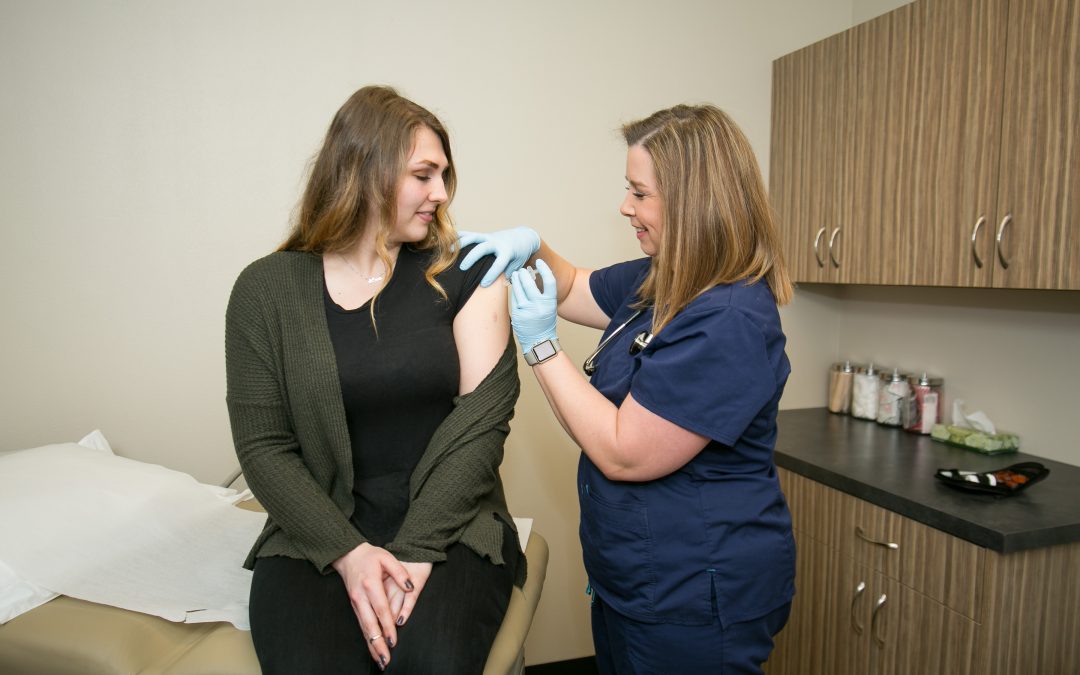
by administrator | Nov 8, 2018 | Flu, Healthy
And so it begins. The leaves are changing, the days are getting cooler, and across the country, the sniffles have started. In homes and schools and offices, tissues and hand sanitizer are making their yearly appearance on desks and counters. Cold and flu season is here. We always hear it phrased together like that – “cold and flu season.” But how do you tell the difference between a cold and the flu?
Both illnesses are viral, not bacterial, and both are circulating through the population all year long. But in fall and winter, the numbers of people infected with either virus climb steadily, sometimes with severe consequences. Why do these viruses suddenly go on the attack? What is the difference between them? And how do you know when it’s time to see a doctor? Let’s walk through that information together here.
Why Now?
Since the viruses responsible for colds and influenza are always around, why do cases of infection pick up steam in the fall and peak in the winter? There isn’t a definitive answer to that, but scientists have come up with a few theories:
- Damp weather. There is some evidence that wet weather makes the viruses easier to spread. Even in tropical countries where there are no significant seasonal temperature drops, influenza is more prevalent during the rainy season.
- School children. After the summer break, schools are filled with hundreds of children in close quarters. Many students have not had a chance to build up immunity to any cold and flu viruses, so they are quick to succumb. They then bring the virus home to their families, and it spreads from there.
- Less time outside. As the days get shorter and cooler, and schools get back in session, people are spending less time outside getting fresh air. Fresh air provides your body’s immune system with much-needed oxygen for fighting off germs.
Just the Facts
Before looking closely at the difference between a cold and influenza, it’s important to dispel some misconceptions and myths about these viruses.
- Influenza is not the same as the stomach flu. Different viruses cause these two ailments. Flu shots will not protect you against the stomach flu.
- Speaking of flu shots, they cannot give you influenza. The virus in the flu vaccine is inactive. Anecdotes of people catching the flu from the vaccine are inaccurate. Those people likely already had the influenza virus percolating in their systems before getting the shot, and the symptoms showed up just in time to convince them that the vaccine caused the illness.
- Being outside in the cold does not give you a cold or any other illness. Contrary to what your grandmother might have feared, this simply isn’t true. The virus must get into your system for you to catch a cold or the flu. It is true, however, that keeping your body warm enough in cold weather does help the body to do its job of fighting off viruses that try to work their way in.
How to Tell the Difference Between a Cold and the Flu
When trying to decide which virus has taken hold of you or a loved one, there are some key pieces of information to notice: onset of symptoms, range and severity of symptoms, and duration of symptoms. Here is an overview of what to look for.
- Onset: Cold viruses typically bring on symptoms slowly. You may feel a little congested or have a scratchy throat off and on for a day or two before fully succumbing to a cold. Influenza, on the other hand, comes on quickly, often within a matter of hours. You may go to work feeling fine, and then by lunchtime feel cold and achy and need to go home.
- Range and severity: Cold symptoms typically stay in the nose-to-throat range. That is, congestion, sneezing, and a sore throat are the most common complaints, with a cough thrown in occasionally for good measure. Influenza brings much more for you to deal with as it attacks the whole body. Headaches, chills, fever, and body aches are highly likely with the flu, as well as a deep and painful cough.
- Duration: Cold symptoms frequently subside within 3-5 days, and may or may not impact daily activities, depending on severity. Flu symptoms, however, can last up to a week or more and pretty much bring normal daily activities such as work and school to a halt.
Cold or Flu, When Should You See a Doctor?
When you are feeling crummy, whether it’s from a cold virus or influenza, usually all you want to do is crawl into bed and wait it out. Sometimes that is the best thing to do, but with these viruses, here are four times that you should get to the doctor instead:
- High fever: For adults, a temperature of 102 or higher that can’t be controlled with fever reducers or that lasts for more than a few days should trigger a trip to the physician. Although viruses do not respond to antibiotics, there are antiviral medications that can bring you some relief. Furthermore, both the cold and flu can develop into a secondary infection like bronchitis or pneumonia, and then an antibiotic may be necessary.
- Intense headaches: If you have severe headaches that do not respond to pain relievers or that impact your ability to think clearly, it’s time to seek medical care. These headaches may indicate that a more serious problem has developed.
- Underlying conditions: Individuals with chronic medical conditions such as diabetes or immune disorders should be quick to see the doctor when cold or flu symptoms present themselves. Even a simple cold can create significant complications for these patients, so it is best to check in with a physician right away.
- Heart palpitations: Dehydration from cold and flu viruses can put your heart under stress and cause rapid pulse. However, viruses can attack the heart lining, causing serious problems. Don’t wait and wonder on this one. Go see the doctor.
Whether you need to get the flu vaccine or think you may already have the flu, the doctors at Camas Swale are here to help. Contact us today, and we will help get you feeling great.

by administrator | Oct 16, 2018 | Flu
What if there was a major scientific breakthrough that could dramatically decrease an individual’s chances for severe and life-threatening illness complications? Furthermore, what if this breakthrough would protect those with weaker immunity from lethal infection including young children and the elderly? What if the scientists who developed the technology made it available at low cost or even no cost? Such a boon to society would be difficult to differentiate from magic. Even more impressive is that this is not some far-fetched imaginary technology. It is the flu shot, available now at pharmacies and clinics everywhere.
What’s the Catch?
No catch. In fact, that may be the problem. The flu shot works so well most years that people think “why get the flu shot, it was no big deal last season”. Or alternatively, a patient gets sick with an unrelated virus and thinks “why get the flu shot if I get sick anyway?” Or, even more commonly, erroneously supposes the flu shot caused an illness and thinks “I always get sick when I get the flu shot”.
Anyone can have an opinion regardless of medical training. With the proliferation of social media and the internet, those opinions can be shared and published without regard for factual basis, or peer-reviewed impartial research and development. The impact of these statements can be even more profound when the person offering the opinion is a celebrity or otherwise well-respected community or society figure.
The Flu Shot and Herd Immunity
Unfortunately, vaccines rely in part on what is called “herd immunity”. This means that the more people in a population are vaccinated, the better it works. When people electively decide not to vaccinate, it places not just those individuals, but the whole population at risk. There is a resurgence in the Pacific Northwest in viruses largely extinct in recent memory. This includes the measles and whooping cough: viral diseases that can be prevented with routine vaccination. For most people, these viruses result in a self-limiting infection. However, for patients with existing respiratory dysfunction or underlying lung disease, they can prove life-threatening.
Vaccine “Drifts” and “Shifts”
Another wrinkle in the story is that viruses sometimes undergo something called “drift” or “shift”. This can be a small change in genetics, resulting in a less effective vaccine (drift). It can also result in a large rapid change in genetic structure, resulting in a more virulent disease (shift). Those who remember the Swine Flu in 2009 may recall how much more severe symptoms could be than traditional influenza. In this case, the vaccine may be less effective but may serve to decrease the scope or severity of disease.
Who Should Get Their Flu Shot?
For adults with egg allergy other than hives: Administer IIV or RIV (influenza vaccine) in a medical setting under supervision of a health care provider who can recognize and manage allergic conditions.” (Center for Disease Control, Adult Immunization Schedule for 2018). The Flu Shot is recommended for everyone else, including expecting mothers.
Damon Armitage, MD
Medical Director, Camas Swale Medical Clinic

by administrator | Sep 14, 2018 | Flu, Healthy
Parents around the country are gleeful as they watch their kiddos hop on the school bus or walk through the school doors. Most are ready to get back to a schedule that includes the chance to have enough time to miss their children. No shame in that. So, the big question now is, how do you keep your kids healthy in school?
Every parent knows that the start of the school year also signals the beginning of cold and flu season, especially anywhere kids congregate. The incredible ability for children to share every germ possible, quickly, is almost a superpower.
How do you slow down the spread? How can you help your child remain healthy during the school year, so he doesn’t miss school? Let’s look at some tips and information.
Good Attendance Is Critical
Research is becoming more and more clear about the essential nature of consistent school attendance. Students who miss an average of two or more days of school per month are less likely to graduate high school.
In addition, absenteeism specifically in September is a significant indicator of how much school a child will miss through the remainder of the year. Students who miss 2-4 days of school in September go on to lose an average of 25 days for the year. Clearly, helping your child to start the year with healthy habits will pay off in the long run. So, how do you help your children avoid the gunk, so they don’t have to stay home from school?
8 Ways to Help Keep Kids Healthy in School
When it comes to trying to avoid absenteeism by helping your students maintain good health, prevention is key. Following these tips and habits will go a long way in keeping your children able to go to school.
1. Establish Good Sleep Habits
Quality, consistent sleep is one of the most important needs your child has. Disrupted or inadequate sleep often leads to forgetfulness, irritability, and inattentiveness. Poor sleep also suppresses the immune system, making your child much more likely to catch any bugs going around. Helping your child to develop and maintain good sleep patterns is one of the best things you can do to set him up for school-year health and success.
2. Establish Healthy Eating Habits
Making sure your child has breakfast each day, even if it is a small amount, will help keep his immune system functioning well. Help your child pack lunches with a variety of healthy items. School lunchtimes are often quite short, so be sure the food in your child’s lunch is nutritionally powerful. Nuts, beans, eggs, whole grains, and fresh fruits and veggies will keep your child’s body fueled so that it can do its job of fighting off germs.
It may be hard to believe it’s only been about 150 years since we learned that hand hygiene halts the spread of disease, but it really is that recent. Fortunately, it is not a complicated process, but it does require consistency. Teach your child to wash after using the restroom, after blowing his nose, and both before and after eating.
4. Teach Your Child How to Cover Coughs and Sneezes Correctly
Many adults still fall into old habits of using their hands to cover their mouths when yawning, coughing, or sneezing. But the proper way to cover up is by using the elbow. This method drastically cuts down on the spread of germs since it is unlikely your child is picking up toys, pencils, or food with his elbow. This one habit is a tremendous help in keeping kids healthy in school.
5. Remind Your Child Not to Share Food and Water Bottles With Friends
This is pretty much a surefire way to spread any illnesses that are lurking. It can be a hard habit for little ones to remember when so much of school time is spent teaching them how to share, but keep reminding them that food and drinks can be shared with family, but not with friends at school. And on the topic of sharing, encourage your children not to share combs, brushes, and hair ties to avoid spreading head lice. It’s every parent’s worst school year nightmare.
6. Be Sure Your Child is Getting Plenty of Exercise and Fresh Air
As more and more schools shorten their recess and PE times, it is critical that your child has time each day to play outside. Fresh air gives your child’s body the oxygen it needs to fight off viruses and bacteria, and it boosts the body’s white blood cells for a healthier immune system.
7. Be Aware of Signs of Anxiety or Depression in Your Child
School can be a stressful place for children. Long days with little opportunity for movement can take a toll on a child’s mental health. Add in academic difficulties, bullying, or worries about world problems, and your child could feel overwhelmed quickly. Watch for indications that your child is struggling with anxiety. Things like irritability, inability to sleep, and a lack of appetite may warrant a talk with the school counselor or your child’s pediatrician.
8. Don’t Over-Sanitize
This may sound counterintuitive, but research is becoming more and more clear that children need to spend some time getting dirty. Our gut needs a variety of microbes to help keep us healthy, and playing in the dirt helps us get those microbes. Avoid the urge to buy antibacterial and antimicrobial everything. Over-sanitizing your child’s world likely will have the opposite effect from what you anticipate and could stop him from staying healthy during the school year.
In spite of your best efforts, it is still likely that your child will catch something during the school year. Your child’s school should have an illness policy to help determine if your student needs to stay home. Be sure to follow this policy to avoid further spreading illness at the school.
At Camas Swale Medical Clinic, we look forward to partnering with you and your family as you work toward maintaining good health through the school year and beyond. Reach out today to make an appointment with Dr. Armitage.



